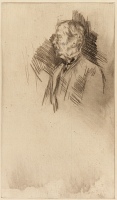KEYWORD
TITLE
The identity of the sitter is known but his title varies, as for example:
'
Sir Garnet Wolseley' (1877,
Charles Augustus Howell (1840?-1890)).
7
'
Lord Wolseley' (1886,
Frederick Wedmore (1844-1921)).
8
'
Wolseley' (1887/1888, Whistler).
9
Wolseley was not a Lord at the time of the drypoint, which is why Whistler called the portrait '
Sir Garnet Wolseley' in 1877. However, by the time Wedmore and later cataloguers were writing, Wolseley was a Lord, and they accordingly called the print 'Lord Wolseley'. The original title is preferable.
DESCRIPTION
The quarter-length portrait of a man, seen in profile, looking to left. His hair is straight, cut close at the back, and thinning on top; his moustache is short, slightly bushy, his beard, short and pointed (Mansfield identified the beard as an 'imperial'). He wears a black, glossy cravat under shirt collars turned up in modest points, a plain waistcoat and jacket. Mansfield described this as 'civilian's dress.' 10
Wedmore misleadingly stated that Wolseley was 'looking to the right.' It is true that since the print reverses what was on the plate, Wolsely was actually looking right at the time, in relation to the artist, but this is not what the viewer sees in the printed image. 11
SITTER
Garnet Joseph Wolseley (1833-1913). He was at this time well-known as a distinguished officer, civil servant and statesman, as well as a painter and etcher. He was not a Lord at the time Whistler drew him, and in a list of purchases by C. A. Howell from Whistler in 1877 this portrait is called 'Sir Garnet Wolseley'.
12
12: Howell to Whistler, 6-15 November 1877, GUW #02178.
The portrait was etched in Whistler's house at 96 Cheyne Walk, Chelsea, London in the years before he moved to the 'White House'. Wolseley was the guest there on several occasions. For instance, after the initial visit, on 25 November, Wolseley noted in his diary for 23 December: 'Breakfasted with Whistler the artist. Rather a dull affair. I confess I cannot enjoy his pictures & should be very sorry to see the English school follow him in careless painting. I like more finish.' 13
He returned the hospitality on 17 January 1878: 'Had a dinner party of odds & ends: the Hopkins, the Skirrows, Butler, Morris, Whistler, the artist, Miss Wright and Miss Armand.' 14
13: Parkins & Cotto's One Shilling Diary, 1877, Hamilton Museums.
14: 1878 Diary, Hamilton Museums.
Whistler probably did not realise that he was an 'odds & ends' and continued to cultivate the Wolseleys. Sir Garnet went at least twice more to Whistler's Sunday breakfasts. On 27 January 1878 he was accompanied by his wife, Louise, and recorded: 'Loo & I breakfasted with Mr. Whistler in Cheyne Walk.' and on 17 March, he wrote merely, 'Breakfasted with Whistler.' 15

Edward Linley Sambourne (1844-1910),
Sir Garnet Wolseley,
Punch, vol 83, 12 August 1882, p. 70.
Numerous photographs, prints, cartoons, drawings and paintings as well as pubs, four-masted ships and so on, attest to Wolseley's fame. For instance there is a gentle caricature of Wolseley in tropical uniform wearing his pith helmet, in a chromolithograph of 1874 by Carlo Pellegrini (1839-1889) who attended the dinner when Whistler made his drypoint, and another by Sambourne, illustrated above, showing Sir Garnet as a fighting cockerel.
Other examples include a woodburytype print by Lock & Whitfield, published by Sampson Low, Marston, Searle and Rivington in 1876; a full length oil by Paul Albert Besnard (1849-1934) of 1880 (private collection); a profile photograph from a glass negative by Alexander Bassano (1829-1913) from the 1880s; and a bust by Whistler's friend
Joseph Edgar Boehm (1834-1890), dating from 1883, as well as many later portraits.
16
16: See the National Portrait Gallery catalogue at http://www.npg.org.uk (accessed 2008).
In 1882, an article in the Liverpool Mercury, occasioned by the news that Wolseley narrowly escaped death when a shell exploded near to him, commented:
'Sir Garnet Wolseley ... used to be a frequent guest at the breakfasts which Mr Whistler gave for years on Sunday mornings at the White House, Chelsea .... Sir Garnet is a slight-built man of average height ... with remarkably bright eyes, hair slightly tinged with grey, and the usual sunburnt complexion of men who have seen service in torrid climates. He is in his "forties", and looks his age, albeit preserving a good deal of juvenility and even boyishness. He is very fond of artistic and literary pursuits, and in the society commonly called Bohemian, he not only holds his own but shines. He has a taste for painting and etching, and indeed has achieved some pleasing landscapes. One of his choicest pleasures used to be to watch Mr Whistler work on his etchings. Perhaps the best portrait of Sir Garnet is an etching by that artist, which he himself possesses. He has altogether an unusually fearless and energetic appearance, and his magnetic attractions as a man such as must make it all but impossible for any troops to fight otherwise than brilliantly under him. Lady Wolseley, it may be added, seems to have many of his personal qualities.'
17
17:
Liverpool Mercury, 29 August 1882 (British Library on-line newspapers, accessed 2008).

